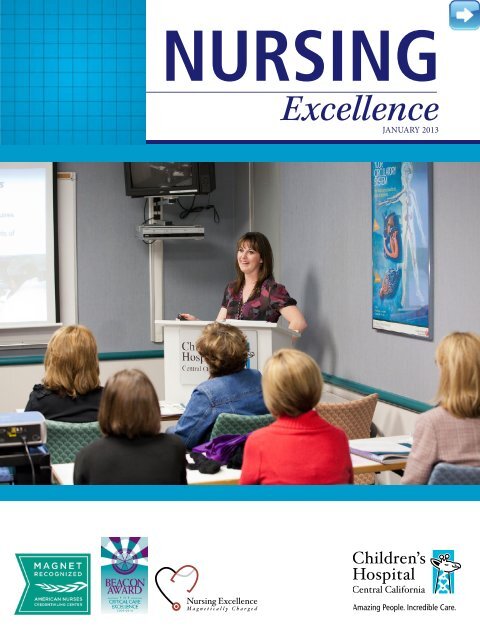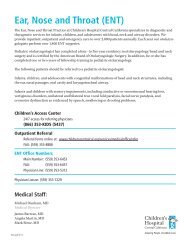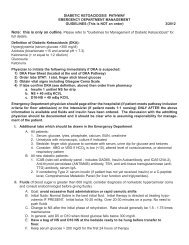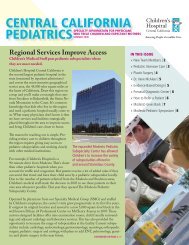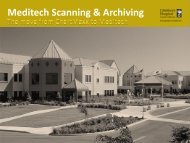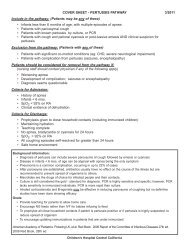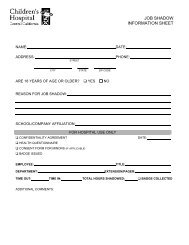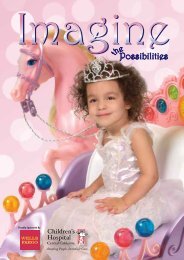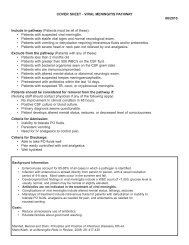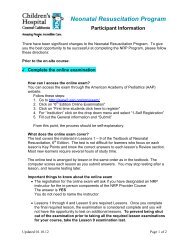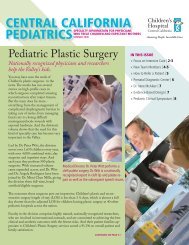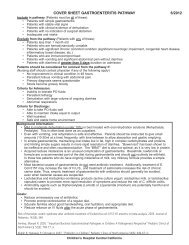Nursing - Children's Hospital Central California
Nursing - Children's Hospital Central California
Nursing - Children's Hospital Central California
- No tags were found...
You also want an ePaper? Increase the reach of your titles
YUMPU automatically turns print PDFs into web optimized ePapers that Google loves.
NURSINGExcellenceJANUARY 2013
January 2013TABLE OF CONTENTSTo navigate through the newsletter, click on any title.The History of <strong>Nursing</strong> Governanceat Children’sBy Beverly Hayden-Pugh, MOB, BSN, RNVice President and Chief <strong>Nursing</strong> Officer<strong>Nursing</strong> Governance – A Component ofour Professional PracticeBy Denise Vermeltfoort, MSN, RN, NE-BCDirector Regulatory and Clinical PracticeGoverning Perspectives- Practice CouncilAllen Henning, BSN, RN, CPN, Chair- Nurse Practitioner CouncilTerea Giannetta, DNP, RN, CPNP, Chair- <strong>Nursing</strong> Research CouncilDonna Wesenberg, BSN, RN, CPN, Co-ChairBetsy Muller, Ph.D., RN, WHNP-C, Co-Chair- <strong>Nursing</strong> Peer Review CommitteeJennifer Norgaard, MSN, RNC-NIC, CNS, Co-ChairPatricia Lindsey, MSN, RN, CNS, CPN Co-Chair- Professional Development CouncilMary-Ann Robson, BSN, RN, CCRN, Chair- Customer Service CommitteeMargi Dragomanovich, BSN, RN, NE-BC, Co-Chair- Family-Centered Care Steering CommitteeYvonne Dominguez, BSN, RNC-NIC, ChairNeonatal Intensive Care UnitPartners in Care CouncilBy Jennifer Norgaard, MSN, RNC-NIC, CNSClinical Nurse Specialist NICUReflection of Ambulatory <strong>Nursing</strong>National CertificationBy Sally Flores, MA, BSN, RN-BC, FCNRN IV Cardiology Clinic
The History of <strong>Nursing</strong> Governanceat Children’s <strong>Hospital</strong>By Beverly Hayden-Pugh, MOB, BSN, RNVice President and Chief <strong>Nursing</strong> OfficerThe history of our governance provides us with a reflection ofthe past, which guides us as we move into the future. Children’s<strong>Hospital</strong> governs the practice of nursing through a participatorygovernance approach.“Participatory governance is an accountability-based approachto relationships and expectations for teams governing theirprofessional practice influencing the delivery of patient careacross the continuum of care.”Children’s <strong>Hospital</strong> <strong>Nursing</strong> Services has a significant and longhistory of excellence through the governance of our practice.Perhaps the most notable part of our practice is the establishmentof clinical standards of practice. The Nurse Practice Teamor as it is called today, the Practice Council, has for decadesprovided leadership in setting the evidence-based standards fornursing practice. <strong>Nursing</strong> staff, educators, clinical nurse specialistsand administrators have worked collaboratively to ensureone standard of care across the continuum of care. This is nosmall feat when you consider the variety of settings in whichnursing care is provided: acute care, critical care, operatingroom, post-anesthesia care unit (PACU), day surgery,emergency, home care, subspecialty clinics, and diagnosticand treatment centers. Through the years, the nurses servingon the Practice Council have ensured a high standard of care.In 2002 an enhanced governance structure was initiated. Itincluded a number of committees including the Executive<strong>Nursing</strong> Council, Nurse Practice Team, <strong>Nursing</strong> Peer Review,Clinical Education, Nurse/Physician Collaboration, ClinicalSystems, Technology and Support, Recruitment and Retentionand Magnet <strong>Nursing</strong> Steering Committee. Over the years newcouncils and committees have emerged and some have beenretired as the needs of nursing and patient care practice haveevolved.A few interesting facts:• The <strong>Nursing</strong> Research Committee was established in2003 to support the conducting and utilization ofnursing research.• The Clinical Systems Technology and Support Committeeand Recruitment and Retention Committee were retired in2004 reflecting the implementation of an interdisciplinaryorganization-wide focus.• A <strong>Nursing</strong> Advocacy Council was added to the structurein 2004. The accountabilities of this committee were latertransitioned into the Executive <strong>Nursing</strong> Council.• The <strong>Nursing</strong> Informatics Council was established in 2007 tosupport the integration of the electronic medical record.• The Magnet <strong>Nursing</strong> Steering Committee was retired in2010 in response to the strong integration of the Forcesof Magnetism throughout the governance structure anddepartments.• Over the past several years, interdisciplinary committeessuch as Lactation, Palliative Care Steering, Patient/FamilyEducation and Cultural and Linguistic Subcommittee inAction were aligned with the Family-Centered Care SteeringCommittee reporting directly to the Executive <strong>Nursing</strong>Council to enhance communication, reporting and planning.The governance of our practice has evolved over the years toinclude innovative processes such as nursing peer review andnursing informatics. Children’s <strong>Hospital</strong> was among the firstorganizations in the nation to adopt the process of nursing peerreview. The quality of nursing care is evaluated by direct carenurses knowledgeable in a similar area of practice to identifyprocesses that may need improvement. With the integrationof new technology, governance of these processes resulted inthe implementation of the <strong>Nursing</strong> Informatics Council, whichintegrates nursing science, computer science and informationscience to manage nursing practice.We have recognized the need to govern all aspects of ourpractice. Governance is managed through a number of nursingand interdisciplinary committees that• develop goals based on clinical and organizational priorities,• establish evidence-based standards of care,• evaluate practice through case review,• monitor and evaluate patient outcomes,• advocate,• develop systems and processes to support nursing care, and• develop and coordinate staff development.In this issue of the <strong>Nursing</strong> Excellence Newsletter, you willbe introduced to the leaders of various <strong>Nursing</strong> GovernanceCouncils. Together with your efforts and participation, we willcontinue to develop innovative solutions to meet the uniqueneeds of our patient population. ❤
<strong>Nursing</strong> Governance – A Componentof Our Professional PracticeBy Denise Vermeltfoort, MSN, RN, NE-BCDirector Regulatory and Clinical PracticeChildren’s <strong>Hospital</strong> <strong>Nursing</strong> Professional Practice Model provides a“framework comprised of 12 elements that encompass attributes,systems, structure and processes that support clinical practice andpromote a professional practice environment.”and governed through the work of the Practice Council, NursePractitioner Council, <strong>Nursing</strong> Informatics Council, ProfessionalDevelopment Council, Patient Care Division (PCD) Leadership,<strong>Nursing</strong> Research Council, and <strong>Nursing</strong> Peer Review Committee.Interdisciplinary Committees are integrated into the structureincluding Family-Centered Care Steering Committee, LactationCommittee, Palliative Care Steering Committee, Patient/FamilyEducation Committee, Cultural and Linguistic Access Subcommitteein Action (CLAS-A), Restraint Subcommittee and Customer ServiceCommittee.The <strong>Nursing</strong> Governance Structure reflects and supports thecomponents of the <strong>Nursing</strong> Professional Practice Model. Severalexamples include:“Professional Practice” is the “structure, standards and regulationsthat govern the practice of nursing.” The Practice Council andNurse Practitioner Council provide guidance on scope of practiceand regulatory requirements related to the practice of nursing.The model is comprised of Professional Practice, Research/Evidence-Based Practice, Care Delivery, Operations, CollaborativeRelationships, Professional Values, Professional Development,Governance, Reward and Recognition, Theoretical Framework andOutcomes. Many structures and processes are needed to supportnursing professional practice and the provision of patient care.These are established and managed through interdependentstructures within the formal <strong>Nursing</strong> Governance Structure.“Governance” is defined in the model as “organizational structurefor the oversight of nursing practice.” The <strong>Nursing</strong> GovernanceStructure at Children’s <strong>Hospital</strong> is comprised of nursing and interdisciplinarycouncils and committees. Leadership is provided by theExecutive <strong>Nursing</strong> Council. The practice of nursing is coordinated“Research/Evidence-based Practice” is defined in the model as “aculture of clinical inquiry, which drives nursing research and resultsin evidence-based practice and sharing of new knowledge.” Thisprocess is supported through the <strong>Nursing</strong> Research Council,Practice Council and Nurse Practitioner Council. The Practiceand Nurse Practitioner Councils develop and revise nursing andadvance practice standards of care based on current evidencebasedpractice. 2 The <strong>Nursing</strong> Research Council promotes andsupports the understanding and use of research to enhanceevidence-based nursing care. The Councils utilize the ACE StarModel© 2005 as the theoretical framework for research andevidence-based practice. When new nursing standards of care aredeveloped, the Practice Council collaborates with the ProfessionalDevelopment Council for the education plan, PCD Leadershipfor resource allocation and implementation, and other councils/committees as needed. The organizational core values ofexcellence, compassionate care, integrity, innovation, collaborationand stewardship are applied to their efforts.“Professional Development” is defined as “programs that supportprofessional advancement, ongoing education, national certification,succession planning and mentorship/precepting.“ TheProfessional Development Council is responsible for improvingand educating to new processes and equipment, developing andvalidating competencies, and creating educational programs.Continued next page
Continued from previous pageThe work of the Council includes management of the Pediatric Nurse Extern Program, Preceptor Development and ClinicalOrientation. The Council provides leadership in the development of educational plans for new products, procedures andequipment such as pressure ulcer, surgical-site infection bundle, Heart Code BLS, new patient beds, pump upgrades andPediatric Early Warning Score (PEWS).“Outcomes” are the “achievement of measurable organizational, patient, workforce and community outcomes throughquality, safety and performance improvement processes.” Quality outcomes are supported through the efforts of allgovernance committees. This includes the Executive <strong>Nursing</strong> Council, which evaluates, monitors and trends nursing-sensitiveindicators such as central line-associated bloodstream infections (CLABSI), ventilator-associated pneumonia (VAP),patient/family satisfaction, pediatric falls, pressure ulcers and many others. The <strong>Nursing</strong> Peer Review Committee monitorsthe quality of nursing care provided to patients while identifying and recommending opportunities for improvementthrough the peer evaluation process. Interdisciplinary committees such as Family-Centered Care Steering Committee,Lactation Committee, Palliative Care Steering Committee and Cultural and Linguistic Subcommittee in Action (CLAS-A)establish and monitor goals focused on enhancing family-centered care.The Councils/Committees integrate to ensure exemplary patient care is provided to the patient and family throughstructures, processes and attributes established through the <strong>Nursing</strong> Professional Practice Model. ❤References(Endnotes)1 Adapted from Vermeltfoort, D., Dragomanovich, M, and Mountcastle, K. Common Components of Current <strong>Nursing</strong>Professional Practice Models in the <strong>Hospital</strong> Setting in the United States of America – A Qualitative Study.2 Bylaws, Practice Council and Bylaws Nurse Practitioner Council, Children’s <strong>Hospital</strong> <strong>Central</strong> <strong>California</strong>, January 2012and April 2012.3 Bylaws, <strong>Nursing</strong> Research Council, Children’s <strong>Hospital</strong> <strong>Central</strong> <strong>California</strong>. January 2011.4 Bylaws, Professional Development Council, Children’s <strong>Hospital</strong> <strong>Central</strong> <strong>California</strong>. November 2011.5 Bylaws, Executive <strong>Nursing</strong> Council, Children’s <strong>Hospital</strong> <strong>Central</strong> <strong>California</strong>. November 2012.6 Bylaws, <strong>Nursing</strong> Peer Review, Children’s <strong>Hospital</strong> <strong>Central</strong> <strong>California</strong>, January 2012.
Continued from previous pageNurse Practitioner Council ChairI started at Children’s as a floor registered nurse (RN) in 1976 but left in 1980 to pursue other clinical opportunities, including gettingmy pediatric nurse practitioner (PNP) certificate and master’s degree. I returned to Children’s as the PNP in hematology/oncology in1992 and have been the chief NP for the <strong>Hospital</strong> for 15 years. I am the first NP with a Doctorate of <strong>Nursing</strong> Practice (DNP), the clinicaldoctorate for advanced practice nurses, here at Children’s.My vision is that advanced practice nursing at Children’s will be a leader in research, education and patient care. Our advancedpractice nurses, which include nurse practitioners (PNPs and family nurse practitioners (FNPs)), clinical nurse specialists (CNSs), andnurse educators, will be the best educated group with the highest number of doctorally-prepared providers in the area.Shared nursing governance results in shared decision making, which leads to better outcomes through leadership, partnership, equity,accountability and ownership. For advanced practice nursing, nursing governance is essential to patient outcomes as we bridge themedical model for patient care with the nursing model of education and holistic patient care. Strong leadership to support advancedpractice nursing through nursing governance is the backbone of advanced practice here, where interdisciplinary team members workcollaboratively and collegially, and where advanced practice nurses make decisions about the way nursing care and medicine ispracticed, delivered and measured for continuous improvement.As the chair of the Nurse Practitioner Council, a member of the Nurse Executive Council, and a member on the Committee for InterdisciplinaryPractice, I have the opportunity to be involved in many levels of nursing and medical practice. These committees collaboratewith others to promote the best practices and policies for patient care. This results in the ongoing benefit of being aware of thepractice changes occurring as well as being part of the decision making for the future of nursing and patient care here at Children’s.Terea Giannetta, DNP, RN, CPNPChief Nurse Practitioner, Hematology ClinicChair <strong>Nursing</strong> Practitioner Council<strong>Nursing</strong> Research Council Co-ChairsI began my career at Children’s <strong>Hospital</strong> in Jan. 1999 as a pediatricnurse extern in PICU and senior focus student in the Explorer/Craycroftinpatient units. After graduating from nursing school in May1999, I was an RN in the PICU and later transferred to Explorer inthe fall of the same year. In 2009 I served as the interim clinicaleducator for Explorer/Voyager, and since 2010 have been in theposition of performance improvement project manager.My vision is that nursing at Children’s can be the best in the nationthrough the use evidence-based practice and nursing research tocontinually improve our performance.<strong>Nursing</strong> governance gives nurses the opportunity to be heard andinfluence the future direction of Children’s.The benefit of being a member of nursing committees and councilsis that we influence change and become aware of future changesto share with staff.Donna Wesenberg, BSN, RN, CPNPerformance ImprovementProject Manager, OutcomesCo-Chair <strong>Nursing</strong> Research CouncilMy career has involved many positions at many facilities in fourstates. All of my work has been in women’s and children’s care. AtChildren’s <strong>Hospital</strong>, I spent over three years as a director in ambulatoryservices. For almost two years, I have been providing nursingconsultation in the patient care support department.My vision is that nursing will continue to expand its recognitionthrough using and conducting research. Research evidence is one ofthe best ways to change practice and practices.Governance is important to all organizations, because it is thegovernance structure that defines expectations, monitors performanceand maintains fairness. It is the governance structure thatensures consistency and cohesion of policies and processes. AtChildren’s, it is important that nursing provides the governance foritself, because it is nursing that is fully knowledgeable about whatit does and how it should do it. In addition, nursing is practicingunder the rules and regulations of the state of <strong>California</strong>, whichassigns the responsibility and liability for nursing practice to thenurse.Service in nursing governance not only provides for personal satisfaction,it contributes to the practice environment of fellow nurses.Betsy Muller, PhD, RN, WHNP-BCClinical Practice Specialist, Patient Care SupportCo-Chair <strong>Nursing</strong> Research CouncilContinued next page
Continued from previous page<strong>Nursing</strong> Peer Review Committee Co-ChairsMy nursing career began here at Children’s in December 1987 as an extern in the neonatal intensive care unit (NICU). I havespent all of my 25 years in the NICU as a staff nurse, satellite resuscitation nurse, charge nurse, clinical educator and now as aNICU clinical nurse specialist.My vision is that nursing at Children’s be recognized for all of the wonderful contributions that directly impact the qualityoutcomes demonstrated daily in patient care.<strong>Nursing</strong> governance is important as it involves clinicians who have the most in-depth knowledge of the needs of the patientsand staff in the decision/policy-making process.While serving as a leader of a nursing governance council, I love the interaction with members from different areas of the<strong>Hospital</strong>. It broadens my view and helps me appreciate those areas I am less familiar with.Jennifer Norgaard, MSN, RNC-NIC, CNSClinical Nurse Specialist, NICUCo-Chair <strong>Nursing</strong> Peer Review CommitteeI began working for Children’s in 1987 as what is now called a pediatric nurse extern (PNE) on South Wing and the adolescentunit (which became Heritage Pavilion and then Discovery/Apollo). After getting my RN license, I began precepting new hires. Ialso worked as a relief charge nurse and diabetic educator. In the 1990s I taught classes for clinical orientation and basic core.In 2000, I became a part-time and later a full-time unit educator for Discovery, sitting on shared governance committees(Practice Council, <strong>Nursing</strong> Peer Review). In 2010 after finishing graduate school, I became a clinical education specialist foracute care/peri-operative services and responsible for managing the clinical student program.My vision for Children’s includes having more nurses at Children’s involved in nursing governance to help find new and innovativemethods for the improvement of patient care.<strong>Nursing</strong> governance allows decisions to be made with various entities at the table. This is important to a facility with somany different types of functioning units. We all have unique working environments, but share a common goal. In order tostandardize care, we need to find approaches that can be adapted for all areas. Therefore, having representation from all areasparticipate in decision making is imperative, whether the decision is about practice, education or operations.Serving on nursing governance allows one to really understand various units and how we can all work toward the same goalto do the right thing for the kids. You exercise your voice about how to achieve that goal. It is also serves as a great insight intoyour own professional practice.Patricia (PT) Lindsey, MSN, RN, CNS, CPNClinical Education Specialist, Clinical Education and InformaticsCo-Chair <strong>Nursing</strong> Peer ReviewContinued next page
Continued from previous pageProfessional Development Council ChairI have been an RN for 20 years working both in the United Kingdom and United States. My career has included nursing in specializedfields such as pediatric cardiothoracic and intensive care nursing, clinical education and staff development.At Children’s I provided direct patient care in the PICU and in the Ambulatory Treatment Center. I also was a PICU clinical educator andam now the clinical education specialist for critical care and life support.My vision for nursing at Children’s includes:• Nurse residency program for both critical care and acute care RNs• Nurse-led Critical Care Outreach team• Nurse-led Code Blue and RRT teams• Development of cross-boundary specialized nursing teams• Movement towards integral multi-professional governance structures• Increased participatory governance at the bedside, with more formalized integration betweenunit- and organizational-based committees/councils.<strong>Nursing</strong> is the largest single body in healthcare. <strong>Nursing</strong> governance is important in order to affect and maintain change within theorganization. <strong>Nursing</strong> buy-in and support are essential. In this era, healthcare organizations either change and grow or die. To engagethis level of support from our nurses they need to be integral to decision making and change management at all levels. In order tocontinue to grow and develop our staff, the nursing profession and Children’s <strong>Hospital</strong>’s strong participatory governance are crucial.There are multiple benefits to being involved in the governance of our profession: greater understanding of infrastructure and howdecisions are made, improved networking opportunities and personal development of leadership skills.Mary-Ann Robson, BSN, RN, CCRNClinical Education Specialist, Clinical Education and InformaticsChair Professional Development CouncilCustomer Service Committee Co-ChairI began my career at Children’s in 1981 at the original <strong>Hospital</strong> site on Millbrook and Shields. I was hired as a nurse tech on NorthWing while I was attending the nursing program at <strong>California</strong> State University, Fresno. A nurse tech in those days was similar totoday’s patient care technician role. Upon graduation in 1982, I was hired as an RN on North Wing. North Wing was a 36-bedsurgery/oncology unit. In 1985 I became an assistant director, roughly equivalent to today’s charge nurse role. As an assistantdirector, I supervised clinical and clerical staff on a medical-surgical-oncology unit including scheduling, evaluation, correctiveaction and staff development. I then occupied various leadership roles including supervisor, acting director, manager and directorof various departments. Today I manage the case management department, which includes case management staff, the palliativecare coordinator and program, and the patient representatives staff and services.My vision is that nursing at Children’s will become an example that others will aspire to and follow as a means to achieve positivepatient outcomes.As professionals, we are all obligated to influence the present and future roles of nursing at Children’s. Involvement in the variouscouncils and committees is the best way for individuals to provide that influence in the organization.The benefits of serving as a co-chair on the Customer Service Committee are that I am able to interact with individuals outside mydepartment, influence the direction of the committee and mentor future leaders.Margi Dragomanovich, BSN, RNManager, Case ManagementCo-Chair Customer Service CommitteeContinued next page
Continued from previous pageFamily-Centered Care Steering Committee ChairI started in the NICU 17 years ago as a unit aide and transitioned into the heath unit coordinator role while taking my prerequisites.I attended <strong>California</strong> State University, Fresno and began training at the bedside during my third semester. I was one of thefirst pediatric nurse externs and graduated summa cum laude in 2001. I became a charge nurse in the NICU in 2008.My vision is to see nurses take a more active leadership role in their home units and in the <strong>Hospital</strong>. Nurses should take pride intheir work and see it as a profession and not just a job. We are affecting hearts and lives on a daily basis and we need to be morecognizant of our roles in the lives of our patients.<strong>Nursing</strong> governance is important to nursing services at Children’s in that it gives autonomy and authority to the unit nurse. Byparticipating in the governance process, we have a voice in the development of policy and procedure at Children’s.Benefits of participating in the governance of our profession are many. I have gained a broader vision of how Children’s functionsand operates, and feel I am participating in something larger than myself. I am helping to create policy and procedure that willaffect the families and patients of this <strong>Hospital</strong> for years to come. It is a feeling of leaving behind a legacy.Yvonne Dominguez, BSN, RNC-NIC,Charge Nurse NICUChair Family-Centered Care Steering CommitteeGovernance of the practice of nursing is an accountability of all registered nurses. The complexity of our practice requires systemsand processes to support the development, delivery and evaluation of nursing care to the patients and families we serve. You areall encouraged to be involved in your unit-based or organizational governance councils and committees. ❤
Neonatal Intensive Care UnitPartners in Care CouncilBy Jennifer Norgaard, MSN, RNC-NICClinical Nurse Specialist, Neonatal Intensive Care Unit (NICU)In 2008, a self assessment performed by the NICU revealedopportunities in several key areas of family-centered care.These included:• The role of parents and families as advisors in the NICU• Education for patients and families• Patient and family supportThis assessment clearly demonstrated that an integral componentto the success of improving family-centered care was missing.The NICU was lacking the leadership and insight only a formerNICU parent could provide. This is the void that our parentpartners have now been able to fill. The NICU Partners in CareCouncil has devoted itself to incorporating former NICU parentsas advisors and partners in the planning, delivery and evaluationof care provided in the NICU. Our parent partners have contributedto the:• Implementation of NICU Parent Chat Night(held twice a month)• Establishment of NICU Parent Lounge, which offersNICU parents a quiet place to eat, rest and rejuvenate• Development of a NICU Parent Facebook page connectingpast and present NICU parents• Establishment of Parent T.I.M.E activities/topics (ParentT.I.M.E stands for Talking and Connecting Parent-to-Parent,Inspired Moments, Making Friendships, Education andEnrichment). Activities/topics include:o scrapbookingo car seat safetyo infant massageo developmental careo breastfeedingThis program strives, in conjunction with clinical partners inthe NICU, to create an environment in which parents cantransition from feeling like outsiders with little control or valuein the care of their infant to true partners in care who activelyparticipate in the daily plan and provision of care.The Partners in Care team recognizes that advancing the practiceof family-centered care is a long-term journey requiringa commitment that evolves with the changing needs and prioritiesof the NICU and the families we serve.The NICU parent partners have far exceeded our expectations bydeveloping the avenues to support and connect with current andalum parents in the NICU. Their contributions to the team areimmense and the value they add to the participatory governanceof the NICU immeasurable. ❤
Reflection of Ambulatory <strong>Nursing</strong>National CertificationBySally Flores, MA, BSN, RN-BC, FCNRN IV Cardiology Clinic, Children’s <strong>Hospital</strong> <strong>Central</strong> <strong>California</strong>As a registered nurse (RN) of 22 years working mostly in theambulatory clinics of Children’s <strong>Hospital</strong> <strong>Central</strong> <strong>California</strong>, Iwas required as an RN IV to obtain a national certification. Idid not expect taking the national certification examinationfor ambulatory nursing to be such a great experience, nor didI expect to have a new awareness and appreciation of howcomplex ambulatory nursing really is. It is good for ambulatorynurses to take a moment to step back and look at thecomplexity and enormity of what we do.As I perused the many areas of nursing certifications, Inarrowed in on what I felt would accurately evaluate thestrengths and talents I developed while spending the last 22years in the following medical areas:• emergency room,• neonatal intensive care unit (NICU),• labor/delivery,• newborn nursery,• gynecology (GYN) inpatient,• radiology sedation nurse,• orthopaedic interim manager,• orthopaedic lead RN,• rheumatology nurse,• <strong>California</strong> Children’s Services (CCS) coordinator,• home health nurse for Synagis program,• Faith Community Nurse program coordinator – Saint AgnesMedical Center (SAMC),• hospice clinical nurse, and• cardiology clinic.I had recently taken a full-time position in the cardiac clinic atChildren’s <strong>Hospital</strong> <strong>Central</strong> <strong>California</strong>, where I learned aboutthe heart and congenital defects in babies. The learning curvewas steep. I had the advantage of being in the clinics formost of my 15 years at Children’s <strong>Hospital</strong>, and as such wascomfortable with clinic flow, patient management, educationand telephone triage. With this wealth of knowledge andexperience mostly in the outpatient and community setting, Ichose the Ambulatory <strong>Nursing</strong> National Certification. I stronglysupport taking the time to properly discern the best certificationto focus on, so that your knowledge and experience willshine through.What I found most rewarding about the experience wasaffirmation of the complexity of our role accountabilities asambulatory nurses. Ambulatory nurses provide patient care,clinic management and an in-depth knowledge of subspecialtypractice to function proficiently in this area of nursing.Ambulatory nursing requires a number of skills that need tobe developed over time in a setting that promotes nursing asa respected healthcare profession and an important partner inthe care of the patient from birth to death.Ambulatory nursing requires specialized skills and competencyin the following areas:• Telephone triage in specific pediatric subspecialty diseasesand conditions• Case management of patient care• Collaboration with other disciplines and outside agencies• Educational skills and abilities to develop disease-specificand age-appropriate material/programs for a specificpatient population• Knowledge of clinic management of patient flow,appointment types and appropriate diagnostic testingduring clinic visits• Exceptional listening and people skills to provide customerservice on the phone and face-to-face with patients andfamilies• Attention to the needs of the whole patient, addressingcultural, spiritual and emotional needs as well as physicaland medical issues• Knowledge of national, state and local healthcare regulationswith regard to professional nursing, scope andstandards, and nursing governance• Participation in ongoing department and hospital-wideperformance improvement projects and the NationalPatient Safe Goals surveillance• Supervision, mentoring and collaboration with other alliedhealthcare workers and volunteers• Willingness to serve as a resource of nursing knowledgeand experienceContinued next page
Continued from previous page• Knowledge and management of insurance as it relates to access to healthcare, medication and diagnostic/treatmentoptions• Proficient computer skills with multiple types of software programs, composing letters, creating tables andspreadsheets as well as policy formats that help track procedures and data collection• Active collaboration with outside professional groups that develop programs and advocate for patient populationsthrough policy making, social events and educational opportunitiesThis list has by no means exhausted all the skills and knowledge required to be an ambulatory nurse. Much more can besaid about ambulatory nurses who care compassionately for all patients and their families, who make sure medication isfilled quickly and covered by insurance, who call just to check on a parent or a patient’s status, who spend time to listencarefully to fears and concerns, who make sure that a diagnosis is fully understood through use of interpreters and timespent answering all questions during a visit, and who comfort a child with a special teddy bear and appropriate stickerswhen they have been poked. Ambulatory nursing reflects a special and unique area of practice.After stepping back and looking at my own nursing practice in this field, I am reaffirmed that we have a very complex anddifficult job requiring many skills developed over years of practice. I am grateful for the experience of preparing for andtaking my national certification in ambulatory nursing. It truly opened my eyes to all that we do and gave me a renewedappreciation for the great nursing care we provide to our patients. ❤


